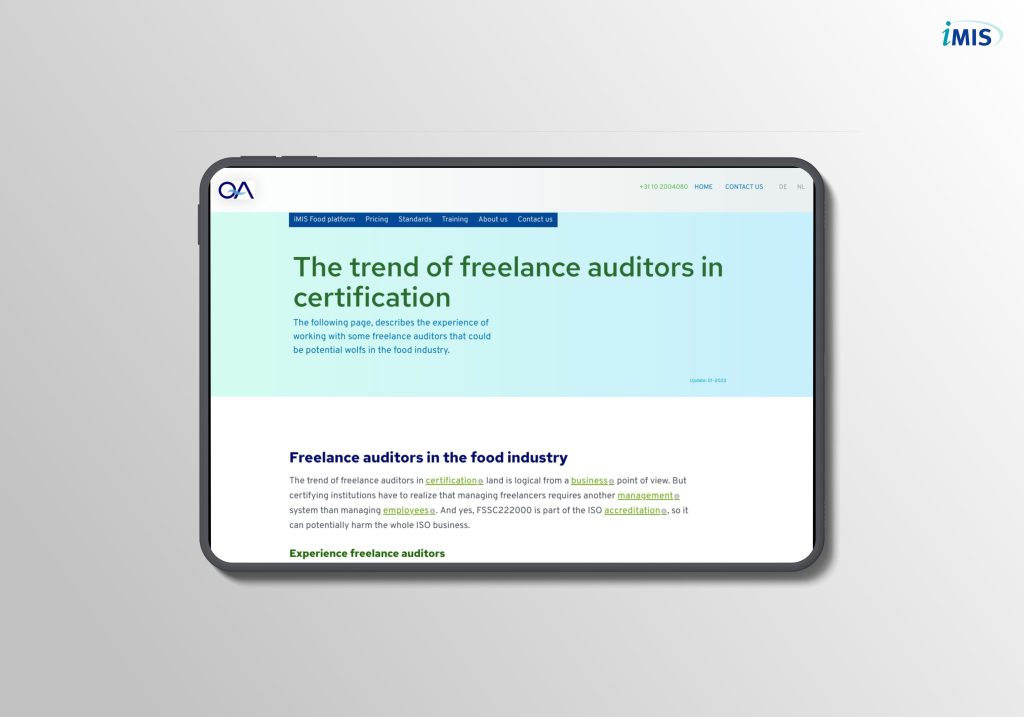The disinfection procedure
To prevent the accumulation of and cross infection with filth and micro-organisms, good cleaning and disinfection is of great importance. Most cleaning operations are outsourced to a specialized company to ensure the proper cleaning and disinfection. Small daily cleaning operations are conducted by our own staff.
Agreements concerning disinfection
There is an agreement made with the cleaning company, where our requirements are recorded. The employees of the cleaning company must hold to our hygiene rules. All employees of the outside company have:
- Health declaration;
- Signed hygiene requirements;
- Proof of qualification;
- Responsibilities.
Procedure topics
The necessary specifications are available for the used cleaning products and disinfectants (MSDS and product information pages with the intended use, recommended dosage, pH, etc.) The departments must be broom clean for cleaning, and the machines dismantled. All production areas are cleaned and disinfected according to fixed schedules. These schedules are recorded in the specifications. The cleaning rules for processing equipment, food contact surfaces, and room cleaning inside high care/risk areas must contain minimal:
- Responsible;
- Item/area that must be cleaned;
- Cleaning frequency;
- Method of cleaning, including dismantling equipment on which cleaning activities must be performed.
- Cleaning solutions and concentrations;
- Cleaning materials;
- Cleaning record and cleaning verification.
Disinfection: Check cleaning result
The cleaning is visually inspected daily before the start of the work. When objects or areas are not clean or not rinsed enough, they must be cleaned again (before it is used in production). The shortcoming is recorded. It is then checked whether the corrective measure has been sufficiently implemented. Edit
Disinfection: Cleaning performance
Alongside the daily inspection is an inspection of the actual performance of the cleaning. The following methods and executions apply:
| Method | Execution | |
|---|---|---|
| A | Alkaline / chlorinated cleaning foam | Remove the contamination with the prescribed cleaning solution, using a brush, cloth, and/ or scouring pad and bucket. In a situation where not a lot of water may / can be used, wet a cloth with a cleaning solution and wring it out, then clean the surface with the damp cloth. |
| B | Alkaline cleaning foam | Apply the prescribed cleaning solution to the pre-cleaned surface using the foam system. |
| C | Disinfection – quat | Set the objects in the prescribed cleaning solution. Let the solution act for a minimum of 5 minutes, then rinse the objects. |
| D | Disinfection – chlorine | Set the objects in the prescribed cleaning solution. Let the solution act for a minimum of 5 minutes, then rinse the objects. |
| E | Acidic cleaning foam | With the help of a foam system, apply the prescribed cleaning solution to the pre-cleaned surface. Let the solution act for 15 minutes (do not let it dry) and then rinse with water at 55˚C and a 20-40 bar pressure. |
| F | Manual cleaning / disinfection and / or immersion | Use the prescribed amount of cleaning and disinfection solution manually with the objects. Let the solution act for at least 5 minutes, and then rinse off. Prepare cleaning and disinfection solution for the immersion bath. Immerse the objects for at least 5 minutes and then rinse again. |
| G | Hand washing | Spread soap evenly over hands for 20 seconds. Rinse hands with plenty of water and dry them, for example, with disposable towels. |
| H | Interim cleaning and killing micro-organisms | Spray the objects using an ND-15 tank, or hand sprayer, making sure to keep the objects wet for 2 minutes. Let the object air dry. |
| I | Scrubber-vacuums | With the help of a scrubber-vacuum machine, apply the prescribed cleaning solution to the floor. For a good result, it is usually better to first apply the cleaning solution with the suction motor switched off (do not let it dry) and after approximately 15 minutes, go over the area again but with the suction motor on. |
| J | Cleaning / disinfection evaporators | Spray the evaporator using an ND-15 tank. |
| K | Chlorine tablet / well | Place a chlorine tablet in the well after cleaning. |
| L | Removal | Remove filth using emmer, sponge, and/or brush and chamois. |
| M | Vacuuming / Sweeping | Remove filth using a broom, dust mop, dustpan and brush, vacuum, or mop. |
| O | External | The external company takes care of the cleaning. |
Residue Control:
To ensure that no contamination of the product occurs with cleaning solution or disinfectant, a residue check is carried out monthly. This check takes place with the aid of test strips (pH or quat).
Disinfection Control:
Agar impressions and (listeria) swabs are taken, possibly in consultation with the laboratory.
Related articles to Disinfection example procedures for food companies?
Many customers and visitors to this page 'Disinfection example procedures for food companies?' also viewed the articles and manuals listed below:



